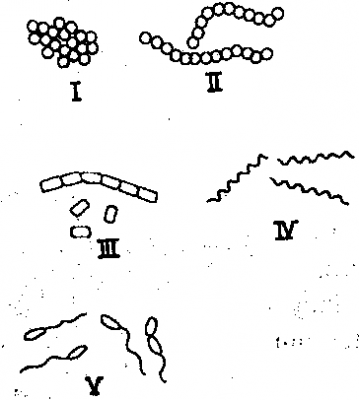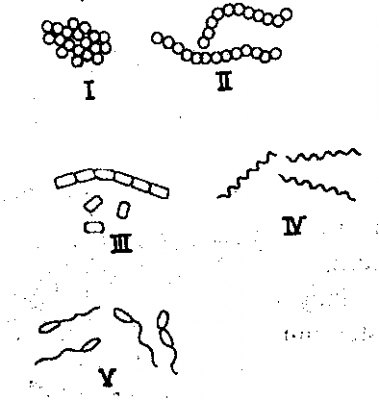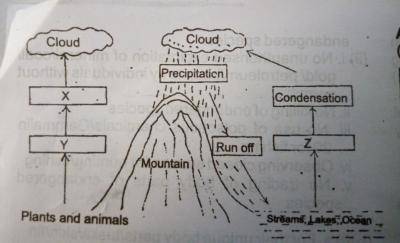Growth in animals differs from that in plants because growth in
- A. plants is indefinite
- B. plants is intercalary
- C. animals is apical
- D. plants is from within

The diagrams above are illustrations of forms in which a particular group of organisms exist. Study them and answer the question.
in which of the illustrated forms does the organism that causes cholera exist?
- A. III
- B. II
- C. IV
- D. V

The diagrams above are illustrations of forms in which a particular group of organisms exist. Study them and answer the question.
Which group of organisms is illustrated?
- A. protozoa
- B. viruses
- C. fungi
- D. bacteria
The food substance that would produce the highest amount of energy is
- A. protein
- B. amino acid
- C. fat
- D. glucose
Which of the following activities is against the conservation of natural resources?
- A. Contour ploughing
- B. establishment of game reserves
- C. deforestation
- D. afforestation
Organisms that feed on dead, decaying tissues of other organisms are known as
- A. saprophytes
- B. autotrophs
- C. parasites
- D. heterotrophs
The ability of organisms to maintain a constant internal environment is known as
- A. diuresis
- B. plasmolysis
- C. endosmosis
- D. homeostasis
The type of nutrition in which organisms take solid organic materials into their body is
- A. parasitic
- B. holozoic
- C. saprophytic
- D. symbiotic
The process by which the amount of water and solutes in the blood is controlled is known as
- A. hemolysis
- B. diffusion
- C. turgidity
- D. osmoregulation

Diagram J is a protease while diagrams K,L,M, and N are food substances, study them and answer this question.
Protease J would react with the particular illustrated substance because enzymes?
- A. k
- B. L
- C. M
- D. N
Study specimens H,K,L,M and N and answer questions a to f
{a} state two observable structural differences between:
{i} specimens H and L
{ii} specimens K and M
{b}i state two ways each by which specimens H and M adapt the organisms to thier modes of life
H…………………………. M……………………………….
[ii] name two types of food that the organism that posseses specimen H feeds on
[c] make a drawing , 8cm to 10cm long of specimen k.
[d] name one habitat of the organism that posseses specimen k
[e] name one feeding habit of each of the organisms that posseses specimen H and L
H……………………………………….. M………………………………
[f] state two observable similarities between specimens:
i H and L
ii k and M
Study specimen D and E and answer questions
(a) and (b).
(a)i Name the specific habitats of each of specimens D and E.
D:…………………………………….
E:…………………………………….
(i) State five observable structural difference between specimens D and E.
(i) What is the behavioural adaptation that specimens D and E exhibit? (b) State two ways by which specimen E is of economic importance.
Study specimen G and answer questions 2(c) to (e).
(c) On the table below, name the types of teeth present in specimen G and state one function each of the types of teeth named.
| types of teeth | one function |
(d)(i) Name the mode of feeding of the organism from which specimen G was obtained.
(ii)(d) Name the mode of feeding of the organism from which specimen G was obtained.
State three ways by which specimen G adapts its organism to the mode of feeding stated in (d)(i)
(e) Name two mineral elements which are needed for the proper functioning of specimen G in the body.
specimens A and C and answer question 1(a) to 1(e).
(a) Classify specimens A and C based on their life cycle.
A;……………………………………………………………
B;……………………………………………………………..
(b) State four observable differences between specimens A and C.
(c) State three ways by which the damage to specimen A could have been prevented.
(d) Name the type of germination that would be observed when specimens A and C are planted.
A…………………………………………………..
C…………………………………………………..
(e) Place a flat side of specimen C on the tile.
provided, cut through the specimen longitudinally.
Make a drawing, 6 cm to 8 cm long of the cut surface of one half of specimen c and label fully.
specimen C and label fully.
(i) Add a drop of iodine solution to the cut surface of th other half of specimen C and record the activity on the table below

5.(a) State three differences between the alimentary canals of earthworm and cockroach.
(i) State three similarities between the alimentary canals of earthworm and cockroach.
(b) The diagram below is an illustration of a biological cycle.
Study it and answer questions 5(b)i) to 5(b)(iii)
[i]Name the biological cycle (i) Explain briefly three roles played by plants and animals in the cycle (ii) Name the process that occur in X, Y and Z.
c. complete the table below.
| organs associated with excretion in human | three diseases that affect the organ |
(d)i) What is decay of organic matter
(i) Name two groups of organisms that cause decay of organic matter.
(i) State one other factor that causes decay.
(iv) Name the biological cycle that involves decay.
(e) Explain briefly the mode of nutrition in carnivorous plants.

5.(a) State three differences between the alimentary canals of earthworm and cockroach.
(i) State three similarities between the alimentary canals of earthworm and cockroach.
(b) The diagram below is an illustration of a biological cycle.
Study it and answer questions 5(b)i) to 5(b)(iii)
[i]Name the biological cycle (i) Explain briefly three roles played by plants and animals in the cycle (ii) Name the process that occur in X, Y and Z.
c. complete the table below.
| organs associated with excretion in human | three diseases that affect the organ |
(d)i) What is decay of organic matter
(i) Name two groups of organisms that cause decay of organic matter.
(i) State one other factor that causes decay.
(iv) Name the biological cycle that involves decay.
(e) Explain briefly the mode of nutrition in carnivorous plants.
(a) What are conversation laws?
(i) State three conservation laws
(b) State two reasons why animals are poached.
(i) Name five animals that are commonly poached.
(c) State four effects of excessive use of the forest.
(d) Explain briefly the following terms: i.blood transfusion ii.antigen
(a)(i) What is an ecological niche?
(i) State five roles played by a mango tree in its ecological niche.
(b)i) State two reasons why ecologists use sampling techniques in population studies.
(i) State four examples of sampling techniques used in population studies.
(c)Name four types of fingerprints in humans.
(d)) Name the plant used by Gregor Mendel in his experiment.
(ii) State two reasons why the plant named in 3(d) was used.
b[ii]state four differences between the definition of a human and a goat
b[i] State three differences between the definition of a herbivore and a carnivore
[a]complete the table below by ticking the appropriate group to which each of the listed elements required by plants belongs
Group
| elements | microelement | macroelement |
| hydrogen | ||
| copper | ||
| magnesium | ||
| zinc | ||
| phosphorus | ||
| manganese | ||
| boron | ||
| nitrogen | ||
| carbon | ||
| oxygen |
[b] [!] state three differences between the definition of a herbivore and a carnivore
[!!] four differences between the definition of a human and a goat
[c] what are milk teeth?


